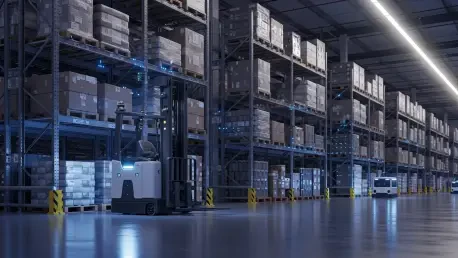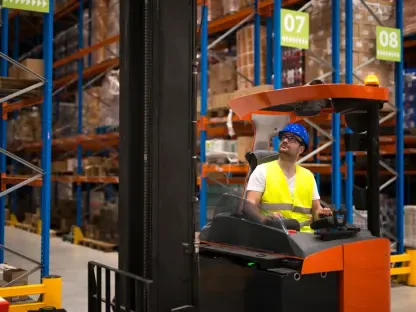Imagine a bustling warehouse where forklifts zip through narrow aisles, handling thousands of pallets daily, and a single lapse in attention could lead to a catastrophic accident, highlighting the critical need for advanced safety measures. In the fast-paced logistics sector, safety is paramount, yet forklift operations have often lagged behind other areas in adopting cutting-edge protective measures. This guide explores a transformative approach to enhancing safety through AI-driven technology, offering actionable insights for warehouse operators and logistics firms aiming to minimize risks and boost efficiency. By delving into proven strategies, the focus is on setting a new standard for workplace safety and operational excellence.
Understanding the Importance of Forklift Safety Innovations
Safety in forklift operations stands as a critical concern within the logistics industry, where the potential for accidents looms large due to heavy machinery and tight schedules. Historically, specialized safety systems for forklifts have been scarce compared to those for larger vehicles like heavy goods vehicles, leaving a significant gap in protective measures. Recognizing this, forward-thinking companies have turned to advanced technologies to bridge the divide, ensuring that drivers and goods remain secure in high-pressure environments.
The adoption of AI-driven safety systems marks a pivotal shift, providing tools to monitor operations and prevent mishaps before they occur. These innovations not only reduce the likelihood of collisions and injuries but also foster a culture of accountability among drivers. By prioritizing such advancements, businesses demonstrate a commitment to safeguarding their workforce, which in turn enhances overall productivity and morale.
This guide aims to outline best practices drawn from pioneering efforts in the field, focusing on how technology can be seamlessly integrated into daily operations. From real-time monitoring to data-driven improvements, the strategies discussed here serve as a blueprint for companies looking to elevate their safety protocols. The emphasis remains on practical, scalable solutions that can adapt to varying operational needs.
Core Best Practices for AI-Driven Forklift Safety
Leveraging Advanced Tracking for Operational Insights
One of the foundational practices in adopting AI safety systems is the use of advanced tracking to gather and analyze operational data. This involves equipping forklifts with technology that records metrics such as speed, braking patterns, and route efficiency. By scrutinizing this information, managers can pinpoint risky behaviors or inefficiencies, allowing for targeted interventions that enhance safety.
Integration of camera systems alongside tracking tools provides a comprehensive view of forklift activities in real time. This dual approach ensures that any unusual activity, such as abrupt stops or erratic movements, is immediately flagged for review. Such visibility empowers supervisors to address issues promptly, reducing the window for potential accidents and fostering a proactive safety mindset.
A practical example of this in action can be seen in hubs where data analysis revealed frequent harsh braking incidents at specific intersections. By adjusting layouts and providing additional signage based on these insights, collision risks were significantly lowered. This demonstrates how data can directly translate into tangible safety improvements when harnessed effectively.
Implementing AI for Driver Behavior Monitoring
Another critical best practice involves utilizing AI to monitor driver behavior, particularly in detecting signs of fatigue or distraction. This technology employs sophisticated algorithms to analyze patterns such as eye movement or response times, alerting supervisors when a driver may pose a risk. Such early detection is invaluable in preventing accidents caused by human error.
To maximize the impact of this system, regular feedback sessions with drivers are essential. These discussions, informed by AI-generated reports, help individuals understand their performance and areas needing improvement. Coupling this with ongoing training ensures that drivers remain vigilant and equipped to handle the demands of their role safely.
Consider a scenario where AI identifies a driver showing signs of drowsiness during a late shift. An immediate alert allows for a quick intervention, such as a break or shift reassignment, averting a possible incident. This proactive stance not only protects the driver but also safeguards surrounding personnel and inventory, underlining the value of AI in real-world applications.
Investing in Comprehensive Training and Scalability
A cornerstone of successful AI safety system deployment is a robust training program for all staff interacting with the technology. This includes educating drivers on how their actions are monitored and providing managers with the skills to interpret data effectively. A well-informed team ensures that the system’s benefits are fully realized without resistance or misunderstanding.
Scalability must also be a consideration from the outset, as operations grow or change over time. Selecting systems that can adapt to increased fleet sizes or new warehouse configurations prevents future bottlenecks. Planning for scalability involves assessing costs and infrastructure needs early, ensuring that safety measures evolve alongside business expansion.
For instance, starting with a pilot program in one facility allows for testing and refinement before a full rollout across multiple locations. This phased approach minimizes disruptions while gathering valuable feedback on system performance. It also builds confidence among stakeholders, paving the way for broader adoption with proven results.
Key Considerations for Industry-Wide Adoption
Reflecting on the journey of integrating AI-driven forklift safety systems, it became evident that this technology reshaped operational standards in profound ways. The ability to preemptively address risks through data and AI marked a significant departure from reactive safety measures, setting a benchmark that others in the logistics sector began to emulate. This shift highlighted the power of innovation in transforming workplace environments.
Looking ahead, companies interested in adopting similar solutions should prioritize partnerships with technology providers who understand the unique challenges of logistics. Conducting thorough cost-benefit analyses and engaging in pilot testing were crucial steps that helped refine implementation strategies. These actions ensured that investments yielded measurable safety and efficiency gains.
Furthermore, fostering an industry dialogue around these advancements proved beneficial in driving wider acceptance. Sharing success stories and lessons learned encouraged other warehouse operators and logistics firms to explore AI-driven safety tools, building momentum for a collective uplift in standards. This collaborative spirit remains essential for sustaining progress and addressing emerging challenges in the ever-evolving field of logistics safety.









